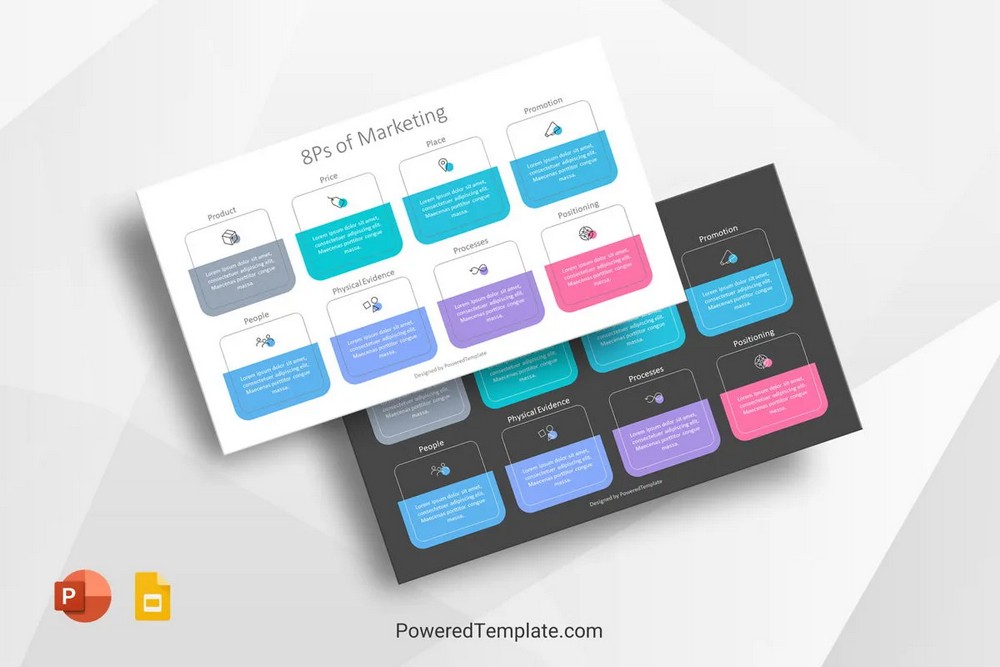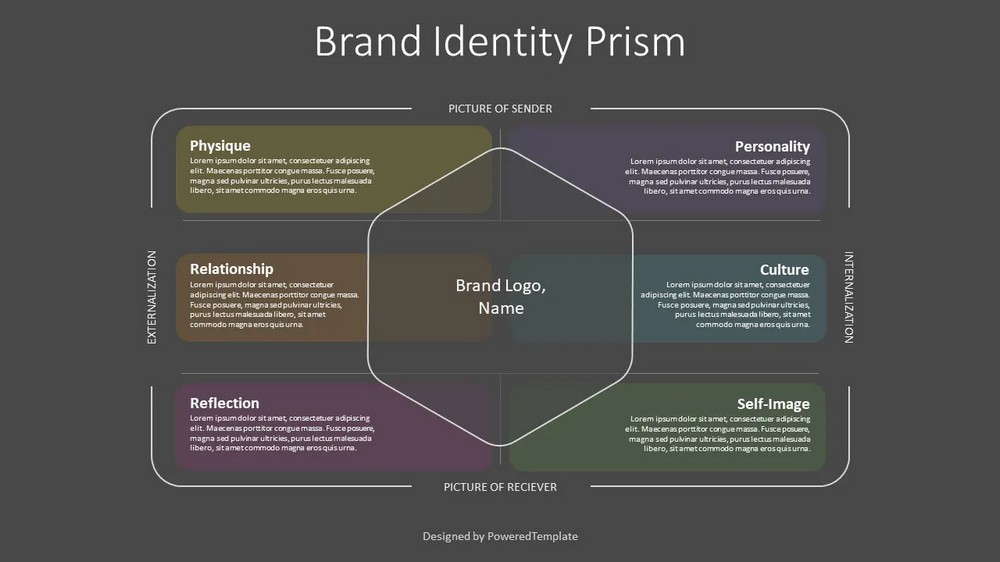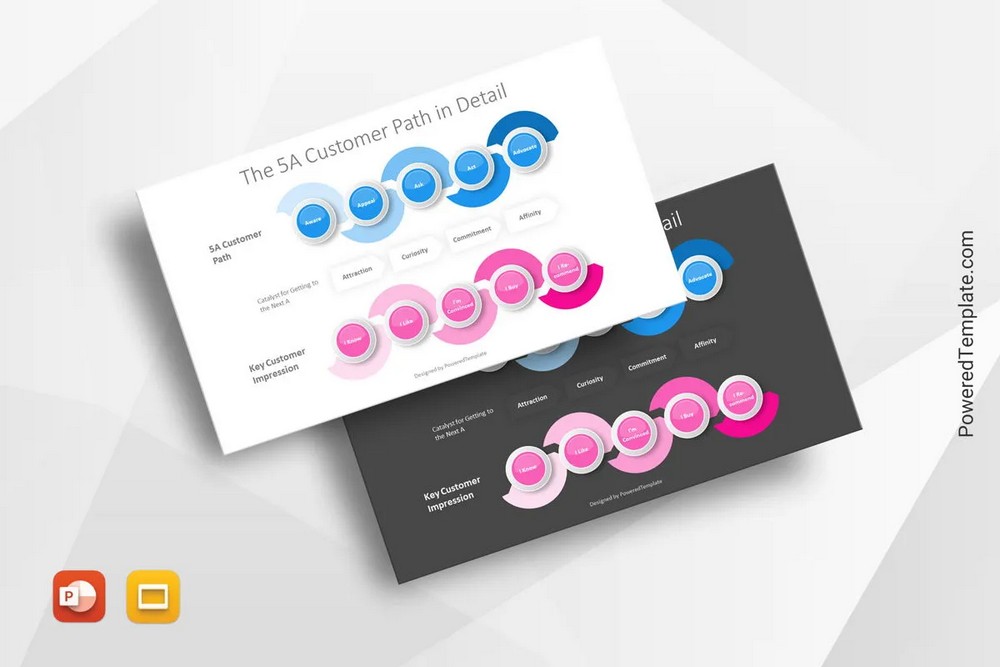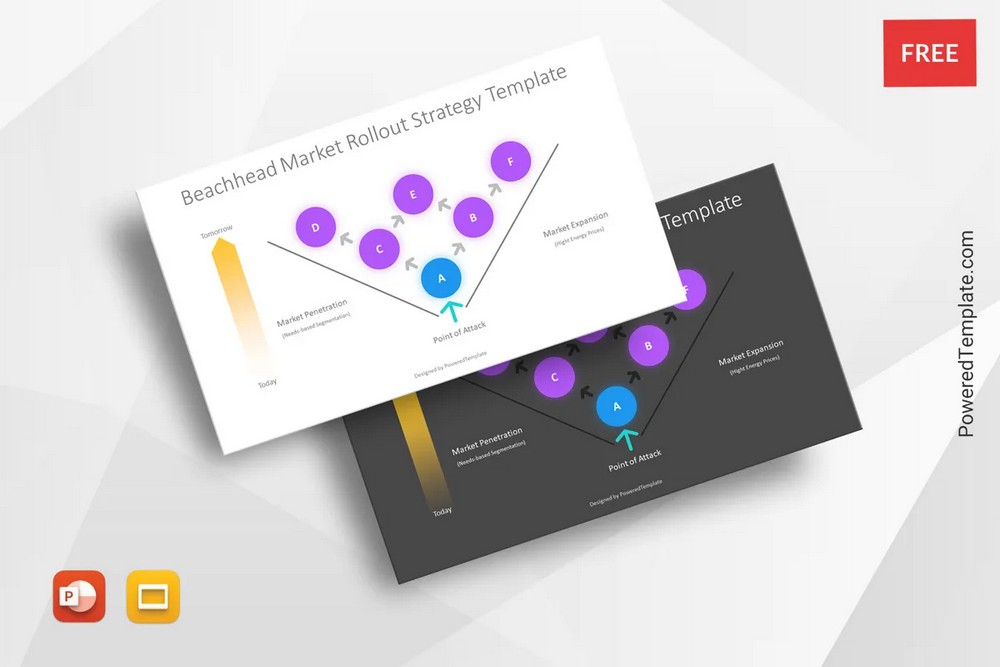This article explores the pivotal role of marketing and sales strategies in successful business management. It covers all key components that are essential to understand in order to optimize marketing and sales efforts for long-term business success.
With this text, we continue a series of eight articles dedicated to business management.
This article presents a collection of tailored presentation templates from the PoweredTemplate library designed for various aspects of marketing and sales strategies in business management. They serve as valuable visual aids for business professionals aiming to enhance their presentations and effectively communicate the significance of marketing and sales strategies to their teams and stakeholders.
Table of Contents
- Importance of Marketing and Sales Strategies in Business Management
- Key Components of Successful Marketing and Sales Strategies
- Understanding the Target Market
- Developing a Strong Value Proposition
- Building an Effective Marketing Plan
- Implementing Sales Strategies
- Integrating Online Marketing and Sales
- Customer Relationship Management
- Continuous Improvement and Adaptation
- Conclusion
Importance of Marketing and Sales Strategies in Business Management
Marketing and sales strategies are crucial for successful business management. They help businesses position themselves in the market, generate revenue, acquire and retain customers, gain a competitive advantage, expand into new markets, build a strong brand, and make data-driven decisions. Implementing effective strategies is essential for thriving in a competitive marketplace.

Key Components of Successful Marketing and Sales Strategies
Successful marketing and sales strategies encompass several key components that work together to drive business growth and profitability. These components form the foundation for effective planning, execution, and evaluation of marketing and sales efforts. Here is an overview of the key components:
- Understanding the Target Market
A deep understanding of the target market is essential. This involves conducting market research to identify target customers, analyzing their needs, preferences, and behaviors, and creating buyer personas to guide marketing and sales efforts. - Developing a Strong Value Proposition
A compelling value proposition is crucial for attracting and retaining customers. It involves defining the unique selling proposition (USP) of the business, identifying key benefits and advantages offered to customers, and crafting a value proposition that addresses customer pain points. - Building an Effective Marketing Plan
A well-defined marketing plan serves as a roadmap for achieving marketing goals and objectives. It includes setting clear goals, selecting appropriate marketing channels (online, offline, or both), creating a cohesive brand identity and consistent messaging, implementing targeted marketing campaigns and tactics, and monitoring and measuring marketing performance. - Implementing Sales Strategies
Sales strategies focus on achieving sales goals and targets. This involves establishing sales goals, developing a sales process and pipeline management, providing sales training and resources to the sales team, leveraging customer relationship management (CRM) systems, and monitoring and analyzing sales metrics to optimize performance. - Integrating Online Marketing and Sales
Online marketing and sales have become increasingly important in today’s digital landscape. This component entails developing a strong online presence through websites and social media, implementing digital marketing strategies such as SEO, SEM, and content marketing, utilizing email marketing and marketing automation, incorporating e-commerce and online sales platforms, and leveraging data analytics for customer insights and optimization. - Customer Relationship Management
Building and maintaining strong customer relationships are critical for long-term business success. This involves providing excellent customer service and support, implementing customer loyalty programs and retention strategies, and continuously engaging and nurturing customer relationships. - Continuous Improvement and Adaptation
Marketing and sales strategies need to evolve and adapt to changing market dynamics. This component emphasizes the importance of monitoring industry trends and market changes, collecting customer feedback and incorporating it into strategies, analyzing and learning from competitors, and making necessary adjustments and improvements to marketing and sales strategies.

By understanding and implementing these key components, businesses can develop comprehensive and effective marketing and sales strategies that drive business growth, enhance customer satisfaction, and achieve long-term success.
Below we explore these components in detail.
Understanding the Target Market
Understanding the target market involves gaining insights into the specific group of customers a business aims to serve. Here are the key elements of understanding the target market:
- Conducting Market Research to Identify Target Customers
Market research helps businesses gather information about their target customers, including demographics, psychographics, buying behavior, and preferences. It involves analyzing market trends, conducting surveys, interviews, and focus groups, and studying competitors to identify the target market segment. - Analyzing Customer Needs, Preferences, and Behaviors
By understanding customer needs, businesses can tailor their products, services, and messaging to meet those needs effectively. Analyzing customer preferences and behaviors helps identify what influences their purchasing decisions and how they interact with brands. - Creating Buyer Personas to Guide Marketing and Sales Efforts
Buyer personas are fictional representations of the ideal customers. They provide a detailed description of their characteristics, challenges, goals, and motivations. Creating buyer personas helps businesses align their marketing and sales strategies with the specific needs and preferences of their target customers.

By understanding the target market, businesses can develop tailored marketing and sales strategies that resonate with their customers, address their pain points, and effectively communicate the value proposition. This understanding forms the foundation for successful customer acquisition, retention, and business growth.
Developing a Strong Value Proposition
A strong value proposition is essential for attracting and retaining customers. It sets a business apart from competitors and communicates the unique value it offers. Here are the key elements of developing a strong value proposition:
- Defining the Unique Selling Proposition (USP) of the Business
The USP is what makes a business distinct and differentiates it from competitors. It highlights the unique features, benefits, or qualities that set the business apart in the market. - Identifying the Key Benefits and Advantages Offered to Customers
Businesses must identify the key benefits and advantages their products or services provide to customers. These could include cost savings, improved efficiency, convenience, superior quality, or any other value that meets customer needs. - Crafting a Compelling Value Proposition that Addresses Customer Pain Points
A compelling value proposition effectively communicates how a business solves customer problems or fulfills their desires. It should clearly articulate the specific benefits customers can expect and how they address their pain points.
By developing a strong value proposition, businesses can effectively communicate their unique value to customers, create differentiation, and establish a strong position in the market. A compelling value proposition helps in attracting and retaining customers, driving customer loyalty, and contributing to overall business success.
Building an Effective Marketing Plan
Building an effective marketing plan is crucial for guiding the implementation of marketing strategies and achieving business goals. Here are the key elements of building an effective marketing plan:
- Setting Marketing Goals and Objectives
Clearly define the marketing goals and objectives that align with the overall business objectives. These goals should be specific, measurable, achievable, relevant, and time-bound (SMART). - Selecting the Appropriate Marketing Channels (online, offline, or both)
Determine the most suitable marketing channels to reach the target audience effectively. This may include a combination of online channels such as websites, social media, email marketing, search engine marketing (SEM), as well as offline channels such as print advertising, events, and direct mail. - Creating a Cohesive Brand Identity and Consistent Messaging
Develop a cohesive brand identity that represents the business’s values, mission, and unique selling proposition. Ensure consistent messaging across all marketing materials and channels to build brand recognition and reinforce the value proposition. - Implementing Targeted Marketing Campaigns and Tactics
Develop marketing campaigns and tactics that are specifically tailored to the target audience. This may include content marketing, social media advertising, search engine optimization (SEO), influencer partnerships, or targeted promotional offers. - Monitoring and Measuring Marketing Performance
Set up mechanisms to monitor and measure the effectiveness of marketing activities. Utilize key performance indicators (KPIs) such as website traffic, conversion rates, customer engagement, and sales revenue to assess the performance of marketing efforts.

An effective marketing plan serves as a roadmap for executing marketing strategies, ensuring a cohesive approach, and maximizing the impact of marketing activities. By following a well-defined plan, businesses can effectively reach their target audience, build brand awareness, generate leads, and drive revenue growth.
Implementing Sales Strategies
Implementing effective sales strategies is essential for achieving sales goals and driving business growth. Here are the key elements of implementing sales strategies:
- Establishing Sales Goals and Targets
Set clear and measurable sales goals and targets that align with the overall business objectives. These goals should be specific, attainable, and time-bound to provide a clear direction for the sales team. - Developing a Sales Process and Pipeline Management
Define a structured sales process that outlines the steps involved in the sales cycle, from prospecting to closing deals. Implement effective pipeline management to track leads, prioritize opportunities, and ensure a consistent and efficient sales flow. - Providing Sales Training and Resources to the Sales Team
Invest in comprehensive sales training programs to equip the sales team with the necessary skills and knowledge to effectively engage with prospects and close deals. Provide them with sales resources, tools, and collateral that support their selling efforts. - Leveraging Customer Relationship Management (CRM) Systems
Utilize CRM systems to manage customer interactions, track sales activities, and maintain a centralized database of customer information. CRM systems help streamline sales processes, enhance customer communication, and enable effective sales pipeline management. - Monitoring and Analyzing Sales Metrics to Optimize Performance
Regularly monitor and analyze sales metrics such as conversion rates, average deal size, sales cycle length, and customer acquisition cost. This data provides insights into sales performance, identifies areas for improvement, and allows for data-driven decision making.

By implementing effective sales strategies, businesses can enhance their sales performance, increase revenue, and achieve sustainable growth. A well-executed sales approach aligns the efforts of the sales team, improves customer relationships, and maximizes sales opportunities.
Integrating Online Marketing and Sales
Integrating online marketing and sales allows businesses to leverage the power of digital channels to reach and engage with their target audience effectively. Here are the key elements of integrating online marketing and sales:
- Developing a Strong Online Presence (website, social media, etc.)
Establish a professional and user-friendly website that showcases the business’s products or services. Optimize the website for search engines (SEO) to improve visibility. Utilize social media platforms to connect with the target audience, share valuable content, and build brand awareness. - Implementing Digital Marketing Strategies (SEO, SEM, content marketing)
Utilize digital marketing strategies to increase online visibility and drive targeted traffic to the website. This includes search engine optimization (SEO) to improve organic search rankings, search engine marketing (SEM) to run paid online advertising campaigns, and content marketing to create valuable and engaging content that attracts and engages the target audience. - Utilizing Email Marketing and Marketing Automation
Leverage email marketing campaigns to nurture leads, build relationships with customers, and drive conversions. Implement marketing automation tools to streamline and automate repetitive marketing tasks, such as lead nurturing, email drip campaigns, and customer segmentation. - Incorporating E-commerce and Online Sales Platforms
Enable e-commerce functionality on the website or leverage online sales platforms to facilitate online purchases. This allows customers to conveniently make purchases online, expanding the reach of the business and increasing sales opportunities. - Leveraging Data Analytics for Customer Insights and Optimization
Utilize data analytics tools to gain valuable insights into customer behavior, preferences, and trends. Analyze website analytics, social media metrics, and sales data to make data-driven decisions and optimize marketing and sales efforts for better performance.

By integrating online marketing and sales, businesses can effectively reach their target audience, generate leads, increase conversions, and enhance customer engagement. The seamless integration of online channels with sales strategies enables businesses to leverage the power of the internet to drive business growth and stay competitive in the digital age.
Customer Relationship Management
Customer relationship management (CRM) focuses on building and maintaining strong relationships with customers to drive loyalty and long-term business success. Here are the key elements of customer relationship management:
- Building and Maintaining Strong Customer Relationships
Develop strategies to build strong connections with customers. This involves providing exceptional customer experiences, personalized interactions, and proactive communication to foster trust and loyalty. - Providing Excellent Customer Service and Support
Delivering outstanding customer service is essential for customer satisfaction and retention. Respond promptly to customer inquiries, resolve issues efficiently, and go the extra mile to exceed customer expectations. - Implementing Customer Loyalty Programs and Retention Strategies
Develop loyalty programs to reward and incentivize repeat purchases. Implement retention strategies such as exclusive offers, personalized recommendations, and proactive customer outreach to retain existing customers and encourage ongoing engagement.

By prioritizing customer relationship management, businesses can cultivate loyal and satisfied customers, resulting in increased customer retention, higher customer lifetime value, and positive word-of-mouth referrals. Effective CRM strategies contribute to business growth by fostering strong customer relationships and generating customer advocates for the brand.
Continuous Improvement and Adaptation
Continuous improvement and adaptation are vital for staying competitive and successful in the ever-evolving business landscape. Here are the key elements of continuous improvement and adaptation:
- Monitoring Industry Trends and Market Changes
Stay abreast of industry trends, emerging technologies, and market shifts. Regularly monitor competitors, industry publications, and market research to identify opportunities and potential threats. - Collecting Customer Feedback and Incorporating it into Strategies
Gather feedback from customers through surveys, feedback forms, and social media listening. Use customer insights to refine products, services, and marketing strategies. Actively address customer concerns and adapt strategies to meet their evolving needs. - Analyzing and Learning from Competitors
Study competitors to gain insights into their strategies, strengths, and weaknesses. Identify areas where the business can differentiate itself and develop competitive advantages. Learn from their successes and failures to enhance business performance. - Making Necessary Adjustments and Improvements to Marketing and Sales Strategies
Continuously evaluate the effectiveness of marketing and sales strategies. Identify areas for improvement, adjust tactics, and explore new approaches to better reach and engage the target audience. Embrace innovation and test new ideas to optimize results.

By embracing continuous improvement and adaptation, businesses can stay ahead of the curve, adapt to changing market dynamics, and remain relevant to their customers. It fosters a culture of innovation, agility, and learning, enabling businesses to proactively respond to challenges and seize new opportunities for growth and success.
Conclusion
In conclusion, effective marketing and sales strategies are integral to successful business management. By understanding the target market, developing a strong value proposition, building an effective marketing plan, implementing sales strategies, integrating online marketing and sales, managing customer relationships, and continuously improving and adapting, businesses can achieve their goals and drive growth.

It is crucial to recognize that ongoing marketing and sales efforts are vital for long-term success. By consistently refining strategies, monitoring performance, and staying attuned to customer needs and market trends, businesses can stay competitive and relevant.
To thrive in today’s dynamic business environment, it is encouraged to implement the outlined strategies. By doing so, businesses can position themselves for success, maximize customer satisfaction, and achieve sustainable business growth. Embrace the power of effective marketing and sales strategies to propel your business towards success.



